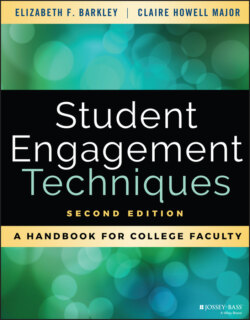Читать книгу Student Engagement Techniques - Elizabeth F. Barkley - Страница 42
Schemata
ОглавлениеA schema, or in plural form schemata, is a cognitive structure that consists of facts and ideas organized into a meaningful system of relationships. Cross (1999) described the concept as follows:
A schema is a cognitive structure that consists of facts, ideas, and associations organized into a meaningful system of relationships. People have schemata for events, places, procedures, and people, for instance. Thus, a schema is an organized collection of bits of information that together build the concept of the college for each individual. When someone mentions the college, we “know” what that means, but the image brought to mind may be somewhat different for each individual. (p. 8)
Our brains have schemata for events, places, procedures, and people. Schemata change and grow as new events, filtered by perception into the schema, are organized and connected to the existing structure to create meaning. One can readily imagine the “rich” schema that would be in the mind of someone who had taught at or attended a specific college (including, for example, memories of courses, classrooms, professors, and so forth) and contrast it with the relatively sparse schema of someone who had simply heard of the college. The potential for errors and misunderstanding is also readily apparent as one considers the kinds of erroneous connections that would result if the person confuses the college with another college with a closely related name or a college that has the same name but is in a different state.
The value of a well-developed schema is revealed in research on the differences between the learning of novices and experts. For the expert in any subject, new information is quickly grasped in useable form because connections to existing knowledge are numerous. The learning of a novice, in contrast, is labored and slow, not because the novice is less intelligent than the expert but because connections between new information and existing schemata are sparse—there are no hooks on which to hang the new information, no way to organize it (Cross, 1999, p. 8; de Groot, 1966).
There are many different devices or behaviors that can help learners acquire and integrate new information with existing knowledge as well as retrieve stored information. These strategies include previewing, summarizing, paraphrasing, imaging, creating analogies, note taking, and outlining. Most experienced learners use strategies such as these to keep their attention focused on the task and their minds actively engaged. These strategies are not necessarily known or used by novice learners. We know, for example, that for new learning to take place, it has to be related to what the learner already knows. The challenge for some students—particularly underachieving students—is that existing knowledge is poorly organized and distressingly sparse. Cross (1993c) offers the analogy of a clothes closet. It is rather easy to hang clothes in a well-organized closet and retrieve them in usable form. Shoes, whether running shoes or dress shoes, have something in common and go on the floor; blouses and shirts are short and can use abbreviated hanging space; some things, such as slacks, go on special hangers; while other items such as sweaters and knits are probably best folded and placed on shelves. The point is that adding and retrieving items is easy when you understand and implement the organizing principles of the closet. If, on the other hand, you just throw things into the closet every which way (cramming it in and shutting the door quickly in the hopes that nothing will spill out!), then it will be a challenge to find the shirt you are looking for, or you might find only one of the socks.
Each schema changes and grows throughout life as new events, filtered by perception into the schema, are organized and connected to the existing structure to create meaning. Thus, new information results in meaningful learning only when it connects with what already exists in the mind of the learner, resulting in change in the networks that represent our understandings.
